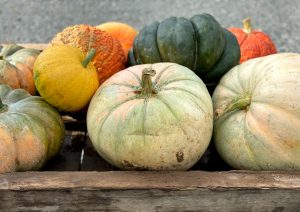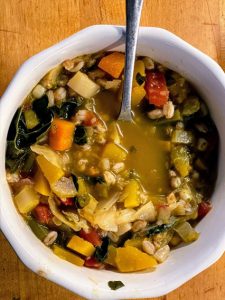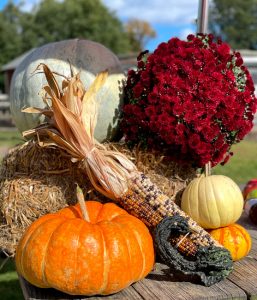Oh My Ghourd!
Oh My Ghourd!
A pumpkin is a cultivar of winter squash that is round with smooth, ribbed skin, most often orange in coloration containing both seeds and pulp. Technically a fruit, and some are gourds, they are packed with nutrition and both the flesh and the seeds are edible. Pumpkin provides many health benefits according to nutritionists including… Read More »

Pumpkins are a beloved Fall and Winter fundamental food on our farm and throughout the United States. Pumpkins are said to have originated from Central & South America and are most known for being main ingredients in Thanksgiving celebrations used in quick breads, filling for pies and included in hearty seasonal soups.
We grow approximately 15 different varieties of pumpkins (all cucurbits) here on our farm which can be eaten or used for decoration or carving. Cucurbits are climbing plants of the Cucurbitaceae family which includes squash, pumpkins, cucumber, gourd, watermelon and cantaloupe. We start our pumpkins from seed planted directly in the ground in late June where they will grow and mature until harvest in September through November (weather permitting). Pumpkins are fairly hardy and drought tolerant and do not require much care. They can take about 90-120 days to mature and we pick our pumpkins at maturity for sale in our markets and also open up our fields for families to enjoy the fun of picking their own pumpkins. Everyone should have a memory of picking the perfect pumpkin for carving at home and enjoying roasting the seeds!
Harvested pumpkins can store for long periods of time if kept in cold storage providing plenty of opportunities to include pumpkins in tasty recipes though the Fall. If looking to store for use in the Winter you may easily prepare, roast, puree, or freeze pumpkin to have it available when you need it.
Pumpkin Tips and facts from our Culinary Specialist, Miss Jenn. Fresh pumpkin can be roasted, pureed and used in recipes. Fresh pumpkins is a little higher in water so you will have to adjust other liquids in your recipes accordingly. Canned pumpkin is not pumpkin, but squash, and it actually is a Dickinson Pumpkin, an heirloom variety very much like butternut and acorn squash. If you like the thick dark orange of canned pumpkin use ½ fresh, ½ canned.

Our culinary & education specialist uses pumpkin in a variety of recipes including this hearty pumpkin vegetable soup. This soup is perfect to have simmering on the stove for those upcoming cold nights in Fall. Warm up with this soup and enjoy the flavors and benefits of trying something new, Pumpkin while in season!
Best wishes from our farm kitchen to yours!








